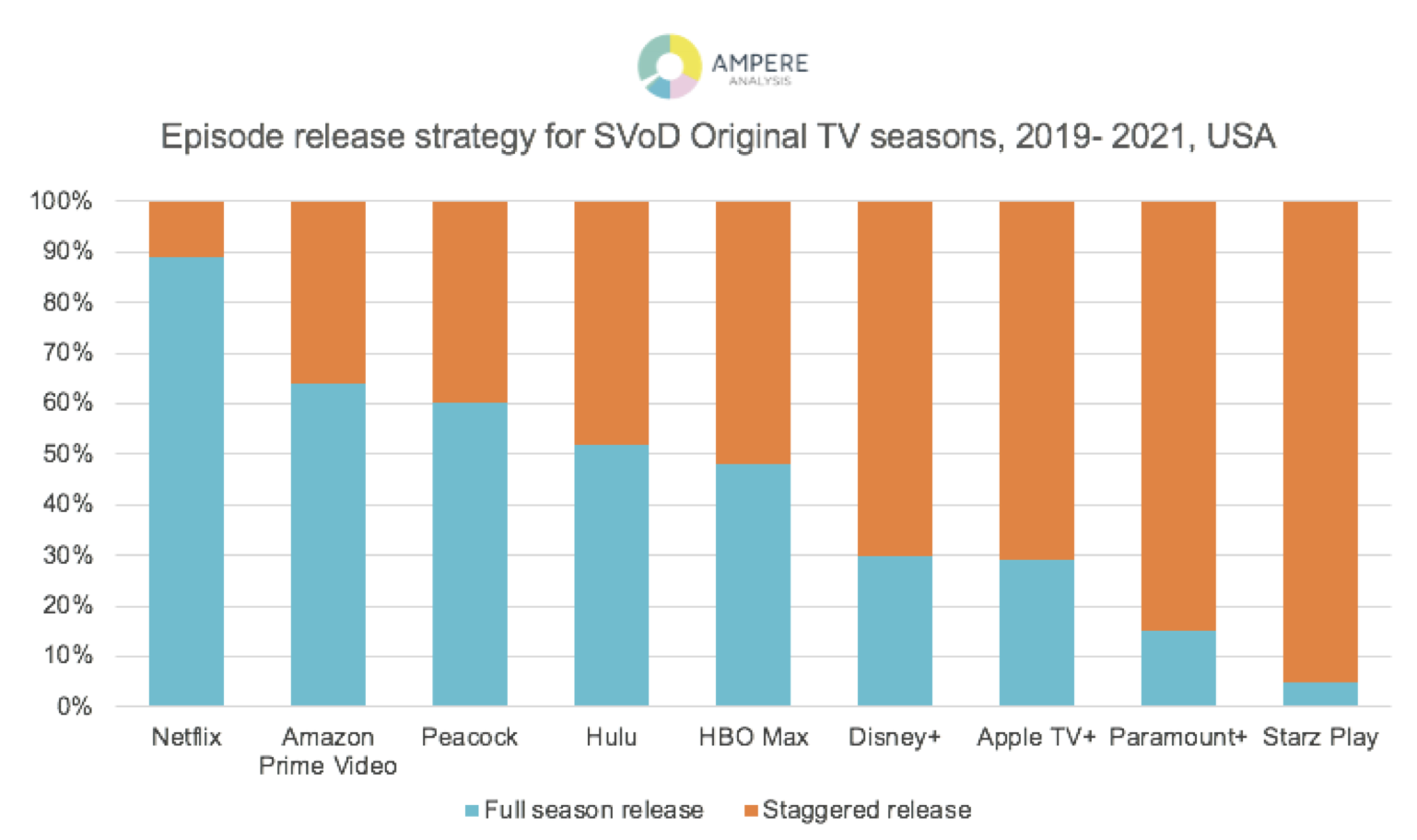The desire of audiences to binge-watch television series changed the televisual landscape, but it is no longer the only strategy in town.

On May 27, 2022, Netflix dropped all seven episodes of the first volume of Stranger Things Season 4 online in one nine-hour bundle. This is the way it has always debuted what remains one of the strongest shows in its arsenal, but as well as the dangers that the residents of Hawkins and elsewhere face from the Upside Down this series, what is new this time round is how that release schedule is now out of step with the rest of the industry.
Netflix, of course, effectively invented the concept of the binge-watch. As our original article from 2017 below states, four years after House of Cards had started the whole thing with all 13 episodes of Series One dropping in one go, pretty much everyone was at it. Five further years on, though, and it seems that Netflix and possibly Hulu are the only ones still sticking to the principle. Stranger Things 4 notwithstanding, the must-watch shows of 2022 so far - a list including the likes of Yellowjackets, Severance, The Dropout, Moon Knight, Winning Time – have all been released via weekly drops. And it is hard to imagine Amazon releasing all of September's forthcoming The Lord of the Rings: The Rings of Power in one go; you don't spend a rumoured $450 million plus on a single series and then release it all in one go.
The chart below from Ampere Analysis details full season releases vs weekly drops from 2019-2021. It doesn't show the direction of travel (Amazon, for instance, has largely abandoned the full season release) but it does show a definite difference in strategies.

Analysis of the schedules unearths some interesting facts too. Ampere reckons that a weekly release strategy across a range of high-profile Originals reduces the risk of churn over time. By way of example, Disney+ released episodes of new MCU TV shows across 34 weeks in 2021. A fan of Marvel content - and there are a lot of them - wishing to avoid spoilers would have to subscribe to Disney+ for the majority of the year to watch each episode at the earliest opportunity. Certainly, shows with a central mystery at their heart, like the excellent WandaVision, have benefited from this approach.
The analyst's popularity score metric, which measures the online search volumes for each title, also shows that engagement drops faster for seasons drops. "In comparing top Netflix (full- season releases) and HBO (weekly releases) shows, the popularity of the former dropped to 80% of the premiere month within one month of release compared to four months for the latter," it writes. "Ampere Analysis concludes that a weekly release helps ensure longevity in engagement more than a full season release would for the same content."
Currently popular with Apple and Amazon in particular is the semi-binge: an initial drop of two or three episodes followed by a weekly release schedule. The idea is that it is the best of both worlds, providing both the initial explosion of interest and a sustained conversation afterwards. It will be interesting to see whether, by the time the fifth and final season of Stranger Things drops, Netflix has changed strategies.
The original article below, written by Nardit Mosacho, was published in March 2017 and offers a detailed snapshot of how the industry had changed at that time. The fact that, five years later, it has changed once more so that binge watching is blended with more traditional weekly drops, just showcases how important it is to evolve strategies to deal with market conditions.
Binge watching 2017
In January 2017, UK pay-TV broadcaster Sky screened the first episode of Season 2 of its high-ticket and often fairly gruesome original drama, Fortitude in a 9pm Thursday evening peak time slot. Nothing particularly unusual about that, but at the same time the broadcaster also made all ten episodes of the show available to its viewers, via its on demand download service.
Those on the linear track were watching it all the way through to the end of March, while those who were happy to binge-watch the show could have finished it easily by the end of the following weekend.
Binge-watching has become such an established part of the cultural landscape that it is difficult to remember that it is a relatively new phenomena, achieving Collins English Dictionary Word of the Year status as recently as 2015. Collins itself defines binge-watching as “to watch a large number of television programs (especially all the shows from one series) in succession.” An oft-cited Netflix survey from 2013 concluded that most Americans defined it as watching anywhere between two to six episodes of a show in one sitting.
It has, of course, been a part of the cultural landscape since cable channels started running marathons of old series which they snapped up cheaply some time in the 80s, and only accelerated with the penetration of video and DVD. What has transfigured it into a genuine cultural phenomena in recent years is that it can apply to first run shows too.
On February 1 2013, Netflix flicked a switch and all thirteen episodes of the OTT giant’s remake of a BBC mini-series House of Cards went live at once. That broadcasters such as Sky are now doing the same as part of a multi-pronged distribution strategy, is testament to the following three ways it has changed television.
The Three Ways Binge-Watching Has Changed Television
1. It has changed how people watch
Deloitte data suggests that 70% of US consumers binge-watch TV shows, with bingers now watching an average of five episodes per marathon session. 31% of those surveyed said they binge TV shows on a weekly basis, rising to 35% amongst baby boomers. Drama is the most popular genre, accounting for 53% of all binge sittings.
Netflix’s own binge scale, meanwhile (below), analyzed more than 100 serialized TV series across more than 190 countries between October 2015 and May 2016. They found that the global media for completing the first series of a show was five days, at a rate of two hours and ten minutes per session.

There’s even a website, Bingeclock, which will tell you how long it will take to binge-watch 8000 individual series with or without the opening titles and closing credits. For the record, every season of House of Cards produced so far, without credits, will take you 2 days, 3 hours and 8 minutes.
2. It has changed how TV is produced
One of the consequences of fulfilling the demand for binge-watching is that is has changed the way that television shows are made, particularly in the influential US market. Whereas once a typical episodic season in the US was comprised of 22 episodes, Netflix and Amazon are making the market more accustomed to much shorter runs, with 10 episodes becoming a popular norm.
What’s more, if all of them now have to be in the can before broadcast, that dramatically changes the networks’ methods. Traditionally, they tested the popularity of show characters and plot lines against audience panels and even canceled series halfway through production following poor ratings.
3. It is changing the way we measure success
The rise of the OTT providers and the binge-watch model has encouraged traditional broadcasters to follow suit; a move which is being aided by more granular methods of audience measurement. The BBC, for example, has experimented with iPlayer debuts of several major series in recent years and, according to rumour, is planning on greatly expanding the initiative to cover all its major new properties.
As Netflix CEO, Reed Hastings, mischievously added in the company’s last earnings report: “We presume HBO is not far behind the BBC.”
Not everyone is convinced on the tactic though. NBC put all thirteen episodes of Season 1 of Aquarius online for four weeks in 2015, but only 6% of viewers watched online. NBC chairman, Bob Greenblatt, also pointed out that the approach is not popular with affiliate stations that rely on TV viewing.
There are also those that state that bingeing means that some water-cooler events, such as the infamous Red Wedding episode of Game of Thrones, lose some of the buzz that builds around them after broadcast.
But for broadcasters it seems to be another legitimate tactic in making sure they can provide viewers with what they want, when they want to watch it and even engage viewers they might otherwise miss. NBC’s research surrounding Aquarius turned up the fact that 50% of people who knew they could binge the show said they were more likely to watch it as a result, and Disney felt able to order a second series of its sci-fi drama ‘Beyond’ a mere eight days after first dropping it onto its servers in January this year.
Roughly 14 million people watched ‘Beyond’ on TV and online during its first week, with around 745,000 — 10% — finishing the season on various platforms in the same time frame. Binge-watching is not a phenomena that is going to go away soon.


